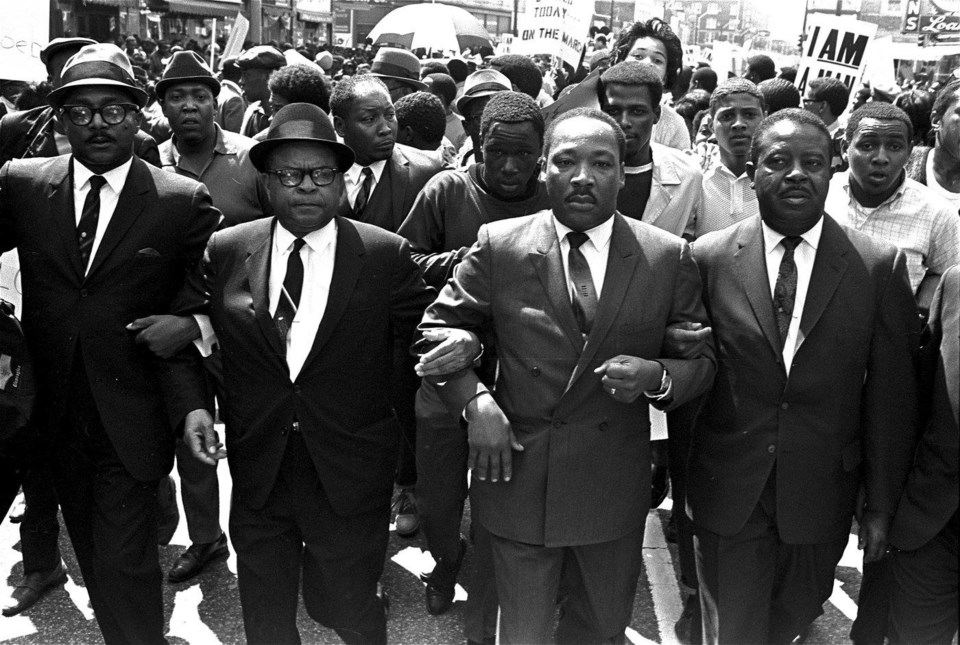MEMPHIS, Tenn. (AP) — A historic Black church in downtown Memphis that was the organizing point for Martin Luther King Jr.'s final campaign in 1968 caught fire early Monday morning and suffered significant damage.
“The inside is a total loss, but we're still somewhat hopeful that some of the facade will be able to be left standing,” Memphis Fire Chief Gina Sweat said at a Monday morning news conference. She said the fire was reported at 1:39 a.m. through a commercial alarm service. Local fire and police officers are investigating the cause, along with the U.S. Bureau of Alcohol, Tobacco, Firearms and Explosives. It is “way too early” to know anything more, Sweat said. King was drawn to Memphis in 1968 to support some 1,300 predominantly Black sanitation workers who went on strike to protest inhumane treatment. Two workers had been crushed in a garbage compactor in 1964, but the faulty equipment had not been replaced. On Feb. 1, 1968, two more men, Echol Cole, 36, and Robert Walker, 30, were crushed in the compactor. The two men were contract workers, so they did not qualify for workmen’s compensation, and had no life insurance.
Workers wanted to unionize, and fought for higher pay and safer working conditions. City officials declared the strike illegal and arrested scores of strikers and protesters.
Before the fire, the Clayborn Temple was undergoing a $25 million restoration that was slated for completion in 2026. The initiative aims to preserve the architectural and historical integrity of the Romanesque revival church and includes the restoration of a 3,000-pipe grand organ. At the same time, the project seeks to help revitalize the local neighborhood with a museum, cultural programing and community outreach, according to a news release on the renovation.
“This morning we woke up to heartbreaking news: a devastating fire has ravaged one of our city’s greatest treasures, Clayborn Temple,” Memphis Mayor Paul Young wrote in a statement posted to social media. “Clayborn is more than a historic building. It is sacred ground. It is the beating heart of the civil rights movement, a symbol of struggle, hope, and triumph that belongs not just to Memphis but to the world.”
Just south of Beale Street, Clayborn Temple was built in 1892 as the Second Presbyterian Church and originally served an all-white congregation. In 1949, the building was sold to an African Methodist Episcopal congregation and renamed Clayborn Temple, according to the release.
Memphis sanitation workers started striking in February 1968 after Cole and Walker were killed on the job.
The Clayborn Temple hosted nightly meetings and the campaign’s iconic “I AM A MAN” posters were made in its basement. The temple was also a staging point for marches to City Hall. They included a March 28, 1968, march led by King, a rally that turned violent when police and protesters clashed on the iconic Beale Street, and a 16-year-old was killed.
When marchers retreated to the temple, police fired tear gas inside. People broke some of the stained-glass windows to escape. King promised to lead a second, peaceful march in Memphis, but he was killed by a sniper while standing on the balcony of the Lorraine Motel on April 4.
After King was assassinated and the strike ended with the workers securing a pay raise, the church’s influence waned. It fell into disrepair and was vacant for years before the renovation effort that took off in 2017 thanks to a $400,000 grant from the National Park Service.
Clayborn Temple was placed on the National Register of Historic Places in 1979.
Anasa Troutman has been leading the restoration effort as executive director of Historic Clayborn Temple.
“To everyone who has loved, supported, and prayed for Historic Clayborn Temple, we are still committed to her restoration,” she wrote in a Monday statement urging supporters to donate money if they are able.
Jimmie Tucker, one of the architects who has worked on the restoration for years, spent Monday morning working on a plan to try to shore up the exterior walls.
“As a native Memphian, this project is personal,” he said. “It has so much meaning.”
Tucker said he had been speaking to some of the people who helped after a similar Memphis fire at First United Methodist Church in 2006. He said that project gives him hope because they were able to rebuild. He was also encouraged that the mayor pledged to support the project.
Young said in a social media statement that the city will “help ensure this sacred place rises again.”
____
Loller reported from Nashville, Tennessee.
Adrian Sainz And Travis Loller, The Associated Press



